Hillel [Encapsulated]
Before moving into its third home, the Madison Hillel Jewish student center discovered a time capsule — but one that missed some of that organization’s highlights. On Wisconsin suggests a few mementos from Hillel’s storied past.
There came a point during the long reconstruction process for Madison’s Barbara Hochberg Center for Jewish Student Life — the Hillel Center — when director Greg Steinberger had to stifle a pang of disappointment.
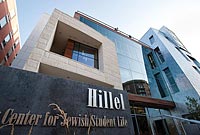
On the same Langdon Street lot that hosted Madison’s old Hillel Center, the new Barbara Hochberg Center for Jewish Student Life (above)gives Hillel its third Madison home. The first site (opposite) was on State Street in the rooms now occupied by Nadia’s restaurant, and was Hillel’s home from 1924 to 1955. Photo: Jeff Miller
It wasn’t just the knowledge that his organization would be without a home for the 2008–09 school year — that was a big deal, true, but he’d known it was coming. The disappointment was caused by a little thing: the opening of a time capsule.
When the old Hillel Center came down, construction workers removed the cornerstone (etched with the date of the building’s completion: 1955 by the common reckoning, 5716 by the Jewish calendar), and behind it, they found a box. Steinberger imagined that this would contain papers and photos documenting Hillel’s history with the UW — the student groups that had met there, the prominent speakers who had come to share their wisdom, the Shabbat dinners.
He was wrong.
Rather than an account of the work Hillel had done, the contents were something like a record of the fundraising that had built its home.
“What we had was a sort of roll call from every county in the state,” he says. “It was materials from Jews who took part in the campaign, those who found pride in building an expression of their Jewish identity.”
This is all well and good, but it doesn’t reflect the considerable color that Hillel has added to the fringes of campus history. Founded in 1924, the UW’s Hillel is the second oldest of its kind. It has provided a gathering place near campus for the UW Jewish community. It hosts religious services and Jewish-themed student organizations, and offers a site where observant Jews can regularly find a kosher meal.
Hillel arrived in Madison during a period when anti-Semitism was widespread in America, and it’s outgrown two homes and seen thousands of students pass through its doors. Its time capsule really should be outstanding. And so we at On Wisconsin would like to suggest three items we would pack away, one for each of Hillel’s homes, should the organization create another time capsule.
The Kenneth Sterling Day Prize given to Louis Behr ’28
When Hillel first arrived in Madison, there was no certainty that it would have any lasting impact — here or anywhere else.
The first Hillel Foundation was created in 1923 at the University of Illinois, gaining sponsorship from that state’s B’nai B’rith lodges, the members of which feared that the campus didn’t offer a particularly welcoming environment to Jewish students. Named for Hillel the Elder, a sage born in Babylon two thousand years ago, the organization evoked not merely religious devotion, but also deep thought and scholarly debate.
Within a year, Hillel was adding chapters at other major Midwestern universities — first UW-Madison, then Minnesota, Michigan, and Ohio State.
But Hillel wasn’t the first UW organization that aimed to serve the Jewish student community. Two others existed before it arrived: in 1911, the Wisconsin Menorah Society was founded, with a mission “to study Hebraic culture and ideals,” and in 1918 Zionist students formed the Palestine Builders Association, encouraging members “to go over to Palestine as near in the future as feasible, in the form of a colony, and do all in our power to help build up Palestine.”
But Hillel had two advantages those organizations didn’t. First, it had Solomon Landman, its initial director and rabbi. Described by the Daily Cardinal as “a popular university preacher [who has] given talks at Princeton, Cornell, Harvard, Dartmouth, and other eastern universities,” Landman was a tireless organizer. He brought in prominent speakers, including UW faculty (such as economics professor Selig Perlman and literature professor Louis Zucker), rabbis from around the country, and clerics from other faiths. He also organized a newsletter — Hillel-O-Grams — a theatrical troupe, and athletic teams that came to dominate the Madison-area church league.
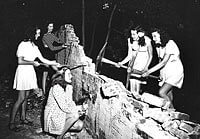
Kiekhofer’s Wall, named for legendary econ professor William Kiekhofer, served as an informal bulletin board before it was destroyed to make room for Hillel’s second home. Hillel offered to have the wall moved to a different location, but souvenir hunters got to it first. Photo: UW-Madison Archives
Second, Hillel had a home: the upstairs quarters at 508 State Street. The rooms there gave the organization a sense of permanence and predictability. By the end of the 1920s, both the Menorah Society and the Palestine Builders Association had come under Hillel’s umbrella.
In the 1920s, the UW was seeing a surge in its Jewish student population. Between 1928 and 1929, the number of Jewish students on campus doubled, according to the Capital Times, making Jews the second largest religious group on campus (after Catholics), and establishing Wisconsin as the Big Ten school with the largest proportion of Jews in its student body.
Not everyone at the university was happy about this. In 1929, fifteen fraternities banded together to form what they called the Apex Dancing Club. Claiming that sorority women were distressed at the number of Jewish students attending dances at the Memorial Union, the club moved its social engagements to off-campus facilities, where it could have invitation-only events.
But once the Apex Dancing Club’s aims became public, it was widely criticized, and in general, the university was welcoming to Jewish students, and especially to Hillel. Consider, for instance, the case of Louis Behr ’28.
As a senior, Behr was the student president of Hillel when he received the university’s Kenneth Sterling Day Prize, granted for displaying “essential Christian worth as evidenced by moral character.”
The prize made news around the country. That an Orthodox Jew from Rockford should be named Wisconsin’s “best Christian” college senior, as the New York World phrased it, struck some as ridiculous. But not Behr.
“I cannot understand the reason for the wide publicity this award is being given,” he wrote to the World. “If I have personal qualities requisite for the Kenneth Sterling Day award — if I have a sound moral character — it is because my parents and my religion have taught me the wisdom of not having an immoral character.”
By the 1930s, Hillel was a permanent part of the campus establishment. UW president Glenn Frank even helped the organization raise funds, writing that he regarded the Hillel Foundation “as an indispensable part of our larger campus life.”
A Kiekhofer brick
The 1940s were a watershed decade for Jewish identity. Two epochal events — the trauma of the Holocaust and the establishment of the state of Israel — forever changed what it meant to be a Jew.
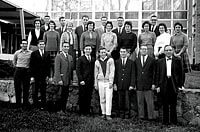
Rabbi and director Max Ticktin (front row right) led Hillel through its effort to build the Langdon Street home. It was his first major fundraising campaign. “I was green as could be,” he says. The building went up in 1953, five years after Ticktin arrived.
At the same time in Madison, Hillel was also going through a massive change. Between 1924 and 1949, the UW’s student population more than doubled, from 7,643 to 18,623, and Hillel’s ambitions rose, too. The rooms at 508 State could no longer accommodate the programs that the organization wished to run. But though Theodore Gordon, the center’s director and rabbi from 1941 to 1948, tried to get a new building, his efforts stalled. Troubles abounded, and the barriers weren’t just financial. There was also a physical obstacle — Kiekhofer’s Wall.
Kiekhofer’s Wall was a brick-and-stone enclosure that surrounded the Langdon Street property of William “Wild Bill” Kiekhofer, a retired economics professor. Students used the wall as an informal message board — postings and graffiti adorned it from the 1920s through the 1940s. But after Kiekhofer sold the property to developers, they in turn sold the lot at 611 Langdon — the section with the wall — to Hillel. If a new Hillel Center was to be built, the wall had to go.
Many students were not pleased.
“The tradition of Kiekhofer’s wall is as much a part of Wisconsin’s history as Milwaukee beer,” wrote a Daily Cardinal editorialist. But preservationist efforts failed to halt the wall’s destruction. It came down in 1946.
And still no Hillel Center went up. That work would have to wait until Max Ticktin arrived in 1948, though he took it over with some reluctance. “I’d never run a building campaign before,” he says. “I was as green as could be.”
But working with the synagogues and B’nai B’rith lodges across the state, he managed to scrape together $85,000 to fund construction. “Although that was a big sum in those days, it actually didn’t take that long,” he says. “We wanted to be masters of our fate.”
The new Hillel House and the arrival of Ticktin proved a boon for Jewish students. As a young rabbi, Ticktin brought energy and intellect to his efforts. He embodied the new age — he and his wife, Esther, had lost family members to the Holocaust, and in 1947 and 1948, they’d spent time in the nascent state of Israel.
Over the course of his sixteen-year tenure, Ticktin forged friendships with faculty — including UW president Fred Harrington, economists Selig Perlman and Edwin Witte, and historians Merle Curti and George Mosse — and with clergy of a variety of faiths around Madison, hoping to increase the educational emphasis of Hillel lectures.
“Madison, as a public institution, had no department of religion or of history of religion,” he says. “We tried to do a lot of teaching — non-credit teaching — and combine that with worship services and with social and recreational activities for students.”
The result was a Hillel that was intellectually challenging. Dolores Adler Erlebacher ’62 says that Hillel “was the place where I first heard about the Holocaust — I mean really heard about it. They had a survivor come and talk to us.”
And Kiekhofer’s Wall? The Hillel Center offered to give the wall to students so that it could be restored elsewhere, but the gesture failed. Souvenir hunters took so many of the stones that the wall was doomed. When workers examined the remaining bricks, they determined that somewhere between twenty-six and thirty layers of paint covered each one.
A menu from the new Hillel Café
When Sharon Byer x’10 and her mother made their first visit to Madison in 2006, Mom made sure they took the brief journey up Langdon Street to Hillel.
“She was familiar with Hillel from its chapter at the University of Maryland,” says Byer, a Silver Spring native. “They’ve got one of the largest and most active chapters, and we’d heard that the Wisconsin chapter is very active, too.”
Finding a thriving Jewish student center was, Byer felt, an important element for feeling comfortable in Madison; she had never spent much time away from the East Coast before and was then getting ready to graduate from the Jewish Day School in Rockville, Maryland.
“The Jewish theme is big in my life,” she says.
Greg Steinberger, the current director of the Madison Hillel Center, knows that making Jewish students — and their parents — comfortable with Madison is still one of his organization’s most important purposes. But making students feel welcome is becoming increasingly complex, as “the Jewish theme” can mean very different things to the UW’s large and diverse Jewish population.
Steinberger came to Madison in 1999, having previously worked with Hillel at Ohio State University in Columbus. There, he says, most of the Jewish students came from within Ohio, making them a fairly homogenous group, but he quickly realized that this wasn’t true at the UW, where most of the Jewish students come from out of state. “This means that they bring a wide variety of experiences and expectations,” he says. This university, he came to understand, would require more physical space than the center then offered.
When the previous Hillel House was built in 1953, the UW’s student body numbered fewer than 14,000, and its Jewish population was around 1,200. Currently, UW-Madison has more than 40,000 students, and Steinberger estimates that 5,000 of them are Jewish.
“It’s not uncommon for many of them to say that their only contact with Hillel is at the High Holidays,” Steinberger says. And this is something he understands — when he was a graduate student at the University of Michigan, he didn’t see much of that campus’s Hillel center until his last year. “That’s when I discovered it was a pretty good place to study,” he says.
In light of this and of his understanding of UW-Madison, Steinberger has developed Hillel’s new home to appeal to students in new ways. The lead donors — Ricky Sandler ’91 and Larry Hochberg ’58 (whose first wife, Barbara, is the building’s namesake) — typify holidays-only Hillel patrons.
“I didn’t spend a lot of time at Hillel when I was a student,” says Hochberg. “I could get all the Jewishness I wanted within my fraternity.”
And so when creating the new building, Steinberger and his colleagues tried to design it to offer students the opportunity to create their own experience. “Eighteen- to twenty-one-year olds, they’re just beginning to figure the world out, to find out what it means to think independently,” Steinberger says. “We want to help them do that, to create a space that helps them figure out how they want to be. We’re a big tent.”
Which, of course, is not literally true — Hillel’s new Barbara Hochberg Center is four stories and 40,000 square feet of stone, steel, glass, wood, and concrete. It’s one of the largest Hillel centers in the country, and it’s also working to earn LEED (Leadership in Energy and Environmental Design) certification, making it one of the greenest structures in the campus area. It includes not only spaces for Reform, Conservative, and Orthodox services every week, but also room for student groups; study areas equipped with wireless Internet access; a gym; and a street-front kosher café that Steinberger hopes will appeal not only to Jewish students, but also to the crowds that walk up and down Langdon Street every day.
The new building may embody what Steinberger sees as Hillel’s future, but it’s also working to fill the organization’s original mission of preserving Jewish identity.
“For five thousand years, people have chosen to participate in this heritage,” he says. “If we’re doing our job well, we’re using our presence to make this campus a richer, better place.”
On Wisconsin senior editor John Allen wishes he had witnessed the destruction of Kiekhofer’s Wall by, evidently, a team of showgirls.
Published in the Winter 2009 issue
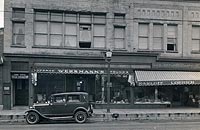

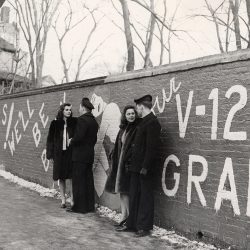

Comments
No comments posted yet.